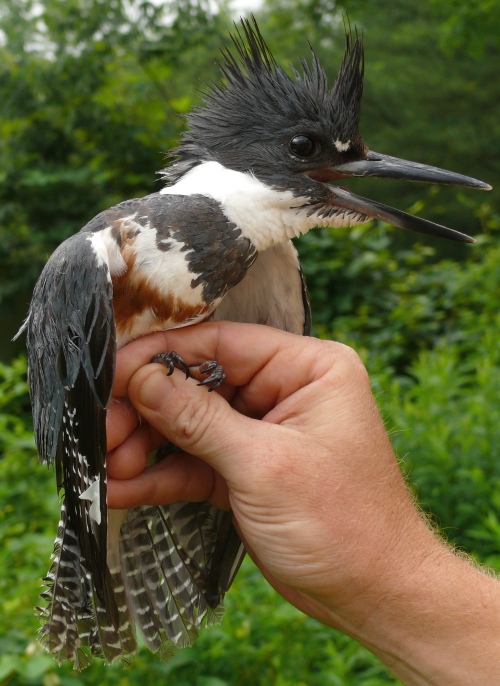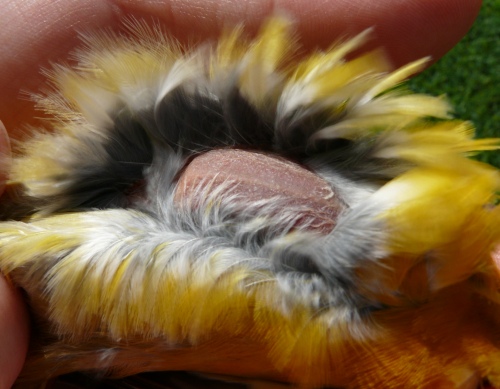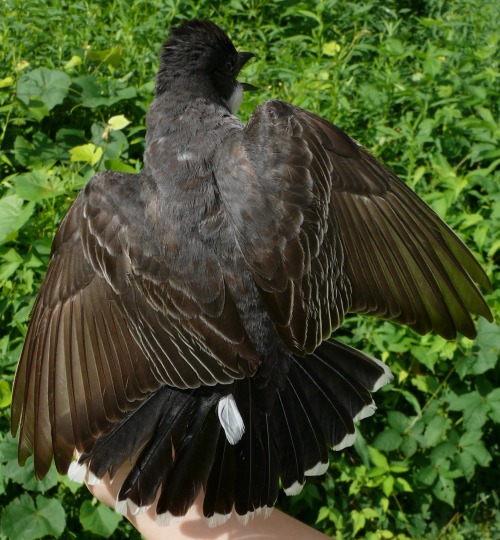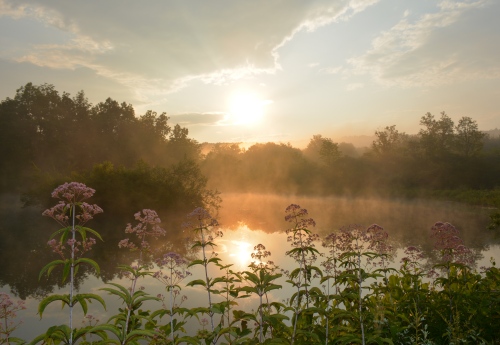June - July 2014
Since banding efforts are reduced in the summer months, things are not quite as busy here at Powdermill. And yet, the banding lab caught 935 birds from the beginning of June to the end of July.
In June many of our resident species are nesting. They stay within their territories to raise and take care of their young and therefore we find fewer in our nets. Of the 212 birds across 36 species that were caught over the month, the top five species were: Cedar Waxing (40), American Redstart (32), Gray Catbird (26), Red-eyed Vireo (16), and Eastern Phoebe (9).
Not unexpectedly, things picked up in July with the dispersal of newly-fledged nestlings. We also have an increase in the capture rate of adult birds who are either continuing to care for their fledglings or those empty nesters leaving their summer residence. Across 56 species, 723 individuals were captured in July.
Our pictorial highlights below for the summer include Belted Kingfisher, Eastern Towhee, Ovenbird, Yellow Warbler, Baltimore Oriole, Eastern Kingbird, Black-billed Cuckoo, and Gray Catbird.

The song of the Ovenbird is one of the most familiar sounds of summer. Their repetitive (and surprisingly loud) vocalizations of “teacher teacher teacher,” echo through the woods. In June, we caught 5 individuals, including this handsome After-second-year male, photographed on the 17th.

Not surprisingly, recently-fledged birds started appearing in our nets toward the middle of the month, including this hatch-year Eastern Towhee caught on the 19th.

Fledglings like this one can be hard to ID at first: good clues indicating this species are its large, rounded head and body, white outer tail feathers, and white wing spot.

This fledgling Yellow Warbler was caught on June 26th, and was one of 8 for the month of June. Rather than simply calling this bird a “hatch-year” it is aged as a “local,” which the Bird Banding Laboratory defines as a young bird incapable of sustained flight.

After banding such young birds, we carefully take them back to the area where they were caught, thus returning them to their natal territories, and to their parents.

Belted Kingfishers are always a nice surprise. Though they are often seen and heard around our ponds, due to their “net-awareness” and size, they frequently escape before we can get to them.
But on June 26th we were lucky enough to extract and band this gorgeous after-second-year female.

The presence of a chestnut band across the chest tells us this bird is female - male Belted Kingfishers will have only the upper blue band. This species is one of only a handful in which the female has more coloration than the male.

Kingfishers use their heavy bills to catch aquatic prey.


This second-year Baltimore Oriole banded on July 3rd was the only one caught this summer.

Not only does her coloration indicate her sex (a male would be brighter, more deeply orange, and more striking overall) but this bird also had a brood patch.
Brood patches in nesting female birds are characterized by a loss of feathers on the abdomen, as well as an increase in blood flow and vascularization, which brings hot blood to the area. These changes increase the amount of heat nesting birds can transfer to the eggs they are incubating.

This adult female Kingbird was a nice find for us. Although our long-term average for this species is close to two per year, we haven't had one in our nets since 2006! This individual was one of two caught this year (both were adult females). We banded this one on July 6th and the second on July 24th.
In flight, the ribbon of white across the bottom of an eastern kingbird’s tail is a helpful field mark. They are the only flycatcher with such a white tail tip.

During mating rituals, eastern Kingbirds display a bright red crest. Otherwise, it’s hidden under black feathers.
Males display their crests more frequently than females.

Black-billed Cuckoos are not a very common species for the banding lab.
This hatch-year caught on July 10th was a nice treat.

Cuckoos eat mostly caterpillars, and show a preference for some noxious species including eastern tent caterpillars and the larvae of the gypsy moth - both species which are detrimental to forest health. Cuckoos are therefore beneficial to forests, farms, and orchards, which are negatively impacted by these over-browsing caterpillars.

Gray Catbirds were the most common bird to be found in the nets at Powdermill this summer.
We never tire of them!

Sunrise over Crisp Pond is one of the most beautiful sights to be seen here at Powdermill Nature Reserve.
Since we open our nets before dawn, it is something we are lucky enough to see each day.
